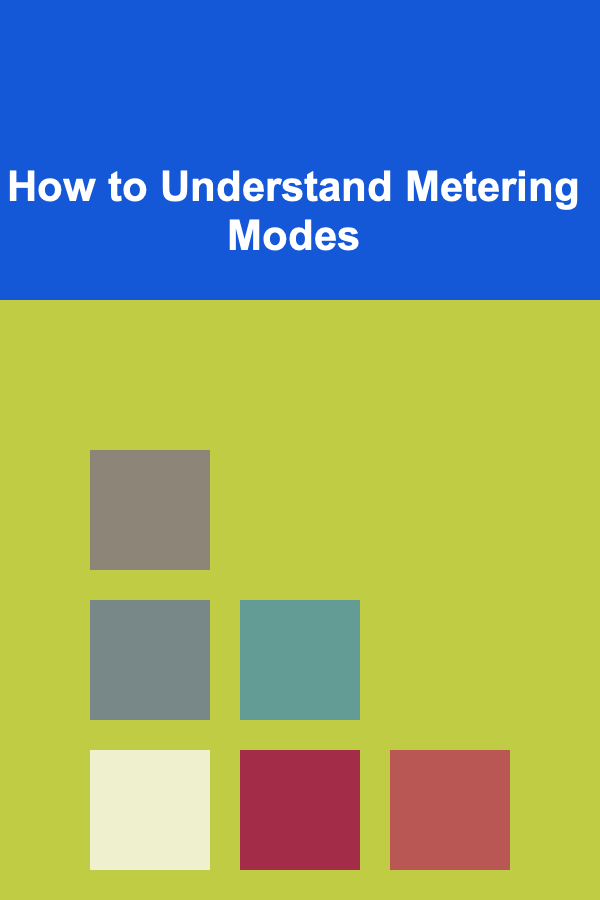
How to Understand Metering Modes
ebook include PDF & Audio bundle (Micro Guide)
$12.99$11.99
Limited Time Offer! Order within the next:

In the world of photography, achieving the perfect exposure is often the difference between an average image and a stunning one. While many photographers rely on the camera's automatic settings, understanding metering modes and how they influence exposure can take your photography to the next level. In this article, we'll explore the concept of metering modes, the different types, how each works, and when to use them for optimal results.
What is Metering in Photography?
Metering in photography refers to the process of measuring the amount of light in a scene to determine the correct exposure settings---shutter speed, aperture, and ISO. Cameras use light meters to gauge the light in a given environment and then calculate how much exposure is required.
The light meter reads the scene and provides a recommendation for exposure. But while automatic metering modes provide a quick solution, they don't always capture the nuances of a scene. This is where metering modes come into play. Different metering modes prioritize various parts of the frame differently, allowing you to control how the camera measures light in a scene.
Why Metering Modes Matter
Exposure is essential for a good photograph. If you underexpose, the image will be too dark; if you overexpose, it will be too bright, losing detail in highlights. The camera's metering mode helps you navigate this challenge by giving you more control over how the camera reads light.
For example, in high-contrast scenes, where you have both very bright and very dark areas, a simple metering mode might either underexpose or overexpose certain parts of the image. Understanding the right mode for the scene will allow you to make sure every detail is captured appropriately.
The Different Types of Metering Modes
Most modern digital cameras offer several metering modes, each with its own way of measuring the light in a scene. The most common metering modes are:
1. Evaluative Metering (Matrix Metering)
Evaluative metering (also called matrix metering in some cameras) is the most advanced and commonly used metering mode on modern cameras. In this mode, the camera measures light across the entire scene and divides it into several zones. The camera then analyzes these zones and evaluates how much light each zone has, factoring in both the subject and the background. It then calculates an overall exposure that will produce a balanced result across the whole image.
This mode works well in situations where the lighting is relatively uniform and there are no extreme contrasts in the scene. Evaluative metering tends to produce accurate exposures in most situations, making it a great choice for general photography.
When to Use Evaluative Metering
- Portraits with balanced lighting: The camera will properly balance the light on the subject and background.
- Landscapes in natural light: It will provide a good exposure across wide scenes.
- Everyday photography: For most casual photos, evaluative metering works reliably.
However, it can struggle in scenes with extreme lighting contrasts, such as bright skies with dark shadows, as it tries to find a balance that may not be ideal.
2. Center-Weighted Metering
Center-weighted metering places the majority of its metering focus on the center of the frame, but it still takes into account the surrounding areas. Typically, about 60-80% of the metering is based on the center area, with the remaining portion factoring in the edges of the frame.
This mode is useful when you want to expose the subject in the center of the image correctly, such as in portrait photography or when you want to ensure that the subject is exposed properly without being influenced too much by the surrounding areas.
When to Use Center-Weighted Metering
- Portraits with the subject in the center: Ensures the subject is properly exposed.
- Isolated subjects in the middle of the frame: If the background is brighter or darker, center-weighted metering prioritizes the subject.
- Scenes where you control the composition: You may want to ensure that the focal point is properly exposed while the edges are less important.
Center-weighted metering is a great option when you want control over how the subject in the center is exposed but still want some consideration of the scene's edges.
3. Spot Metering
Spot metering is the most precise metering mode, and it measures the light only at a very small area (usually around 1-5% of the frame). The area is often located in the center of the frame but can be adjusted on most cameras to focus on a different part of the scene.
This mode is ideal for situations where you want to ensure that a specific part of the image is properly exposed, even if that means ignoring the rest of the scene. It is particularly useful for high-contrast environments or when shooting a subject that is lit differently from the surrounding scene.
When to Use Spot Metering
- High-contrast scenes: To correctly expose a single subject in a complex environment, such as a bright object against a dark background.
- Backlit subjects: To measure the light on the subject itself rather than the background.
- Wildlife photography: When the subject is the only thing of interest in a large, complex background, such as a bird in flight.
Spot metering allows you to expose a specific area correctly, but it requires careful attention, as the rest of the scene may become over or underexposed.
4. Partial Metering
Partial metering is a middle ground between center-weighted metering and spot metering. It meters the light in a larger area than spot metering (usually around 10-15% of the frame), but still gives a great deal of focus to the center. Unlike evaluative metering, partial metering is not influenced by the overall scene; it focuses on the center area to provide more control over the subject's exposure.
This metering mode works well in situations where there is some contrast in the scene, but you still want to ensure the subject in the center of the frame is exposed correctly.
When to Use Partial Metering
- Shooting portraits in moderate light: When the subject is relatively isolated and you want to control the exposure on the face.
- Subjects in the center with a contrasting background: The center is properly exposed while the background can be ignored.
- Scenes with uneven lighting: When you want to avoid overcompensating for bright or dark areas in the background.
5. Highlight-Weighted Metering
Some cameras offer highlight-weighted metering, which prioritizes exposure for the brightest areas of the scene. This is particularly useful in situations where you want to preserve highlights, such as when photographing a bright sky or light sources.
Highlight-weighted metering ensures that the brightest areas in the frame are exposed correctly, even if this means sacrificing shadow detail.
When to Use Highlight-Weighted Metering
- Landscape photography with bright skies: Ensures the sky is exposed well without being overexposed.
- Shooting reflective surfaces or bright light sources: Preserves detail in highlights.
- Scenes with a lot of light contrast: Helps avoid clipping highlights.
While highlight-weighted metering can preserve bright areas, it may result in darker shadows or underexposure in less bright parts of the image.
When to Use Each Metering Mode
The best metering mode to use depends on the scene you're photographing and the result you want to achieve. Here are some practical tips for when to use each mode:
- Evaluative Metering: When you're unsure about the scene or shooting in a well-lit environment with balanced lighting.
- Center-Weighted Metering: For portraits where the subject is in the center or isolated subjects in the frame.
- Spot Metering: In high-contrast scenes, for backlit subjects, or when precise exposure of a small area is essential.
- Partial Metering: When you want to balance exposure between the subject in the center and the surrounding environment.
- Highlight-Weighted Metering: When shooting scenes with bright highlights that you don't want to lose detail in.
Conclusion
Understanding metering modes is essential for improving your photography and controlling how your camera responds to light. Each metering mode has its own strengths and is suited for different types of scenes and subjects. By experimenting with different modes and understanding how they work, you can take more control over your exposure and capture images that truly reflect your creative vision.
The key to mastering exposure lies not only in understanding the technical aspects of your camera but also in developing an intuitive feel for when to use each metering mode. With practice, you'll be able to select the best metering mode for any situation, leading to better-exposed images and more creative control over your photography.

How to Buy the Best Baby Bedding for Safety and Comfort
Read More
How to Clean Your Bathroom Without Harsh Chemicals
Read More
How to Create a Soundproof Baby Nursery for a Quieter Sleep
Read More
How to Launch a Website Development Service for Small Business Owners
Read More
How to Perform Regular Electrical Safety Checks in Your Home
Read More
How to Overcome Procrastination in a Remote Setting
Read MoreOther Products

How to Buy the Best Baby Bedding for Safety and Comfort
Read More
How to Clean Your Bathroom Without Harsh Chemicals
Read More
How to Create a Soundproof Baby Nursery for a Quieter Sleep
Read More
How to Launch a Website Development Service for Small Business Owners
Read More
How to Perform Regular Electrical Safety Checks in Your Home
Read More